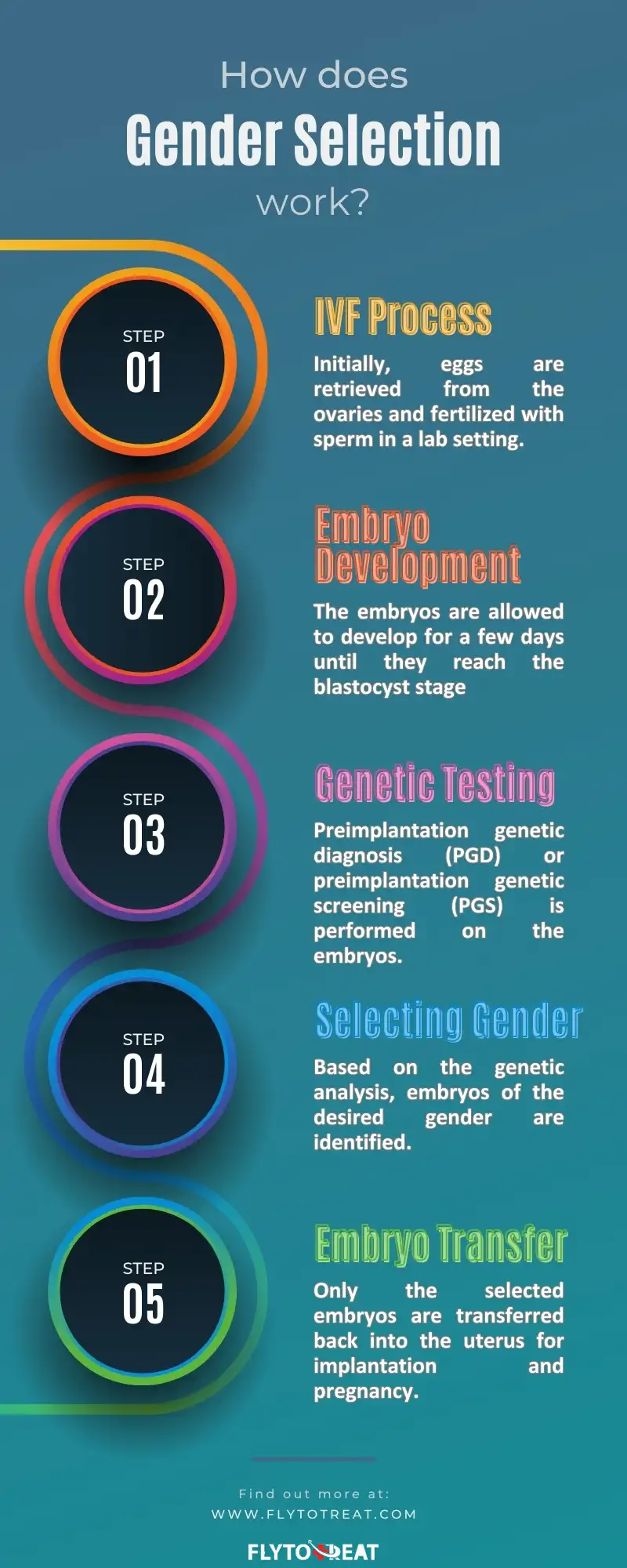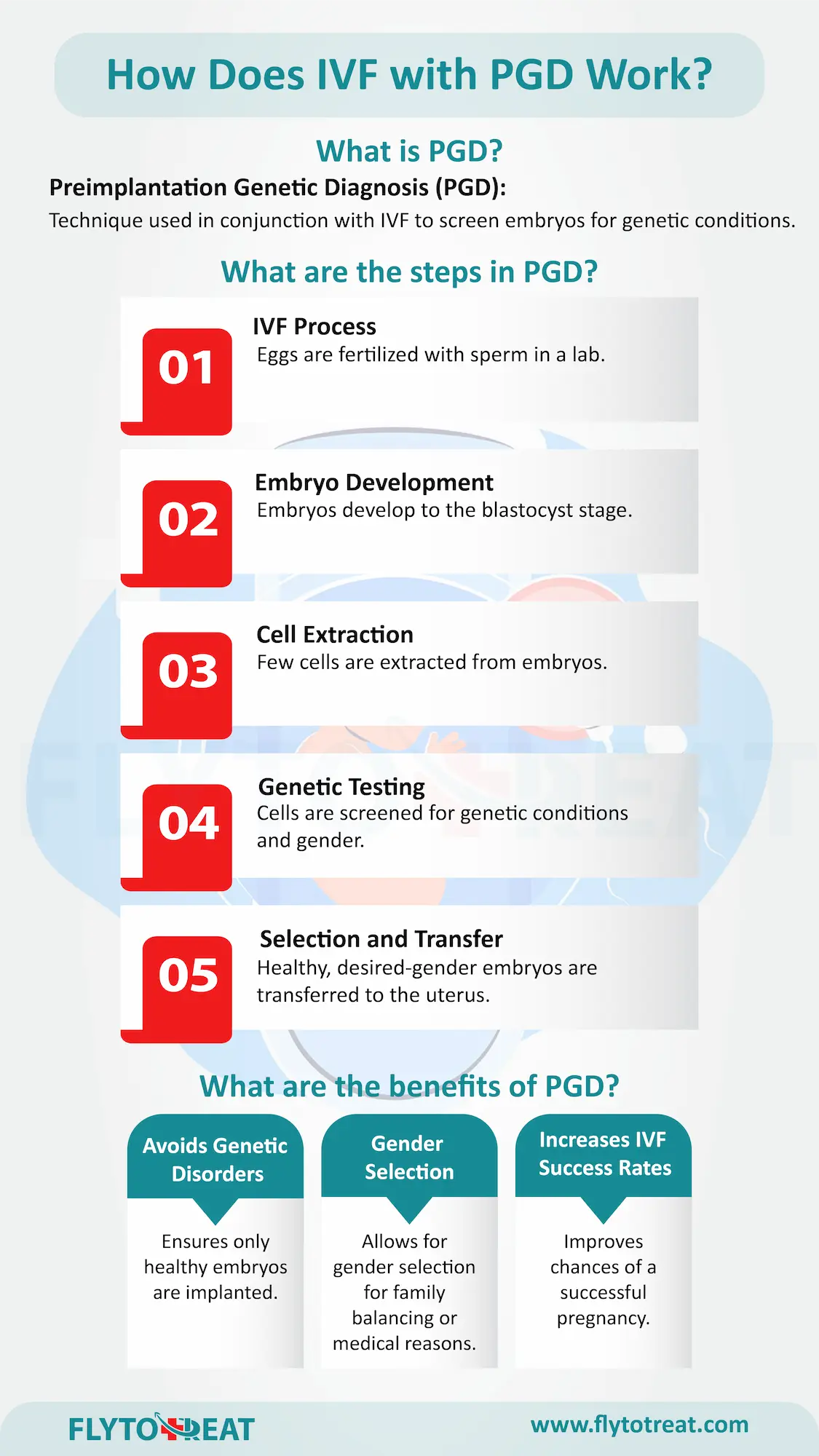
How does IVF and gender selection work?
IVF gender selection has become a popular option for many families seeking to choose the sex of their babies or avoid gender-linked genetic disorders. There are multiple terms when it comes to sex selection in IVF. Here we explore the intricacies of preimplantation genetic diagnosis (PGD) and preimplantation genetic screening (PGS) in the context of IVF. It aims to answer questions such as "What is preimplantation genetic diagnosis (PGD)?" and "How does gender selection work?" The insights provided in this article can assist demystify the processes and advantages of these advanced reproductive technologies.
Can we choose gender in IVF?
To answer this question, we need to introduce PGT, which stands for Preimplantation genetic testing. It encompasses two different procedures: preimplantation genetic diagnosis (PGD) and preimplantation genetic screening (PGS). Both are performed on embryos created through in vitro fertilization (IVF) to assess their genetic makeup before implantation.
Preimplantation Genetic Diagnosis (PGD) is a technique used in conjunction with in vitro fertilization (IVF) to identify genetic abnormalities in embryos before implantation. This process involves:
• Extracting a few cells from the embryos created through IVF.
• Screening these cells for specific genetic conditions or chromosomal abnormalities.
• Selecting healthy embryos for transfer to the uterus.
PGD is particularly useful for couples with a known risk of passing on genetic disorders. By ensuring only genetically healthy embryos are implanted, PGD increases the chances of a successful pregnancy and a healthy baby. This technique can also be integrated with IVF for gender selection, providing couples the option to choose their baby's gender.
What is PGS for sex selection?
Preimplantation Genetic Screening (PGS) for sex selection is a technique used in unity with IVF to identify the gender of embryos before implantation. This process involves:
• Screening embryos for chromosomal abnormalities and gender.
• Selecting healthy embryos of the desired gender for transfer.
PGS ensures the highest chances of a successful pregnancy and allows couples to choose the gender of their baby, often used for family balancing or to avoid gender-related genetic disorders.
Why is PGD Needed?
Preimplantation Genetic Diagnosis (PGD) is essential for detecting genetic abnormalities in embryos before implantation. This process is particularly beneficial for couples with a history of genetic disorders, as it helps prevent the transmission of such conditions to their offspring. PGD can identify a range of genetic disorders, including cystic fibrosis, Tay-Sachs disease, and sickle cell anemia. It also allows for IVF gender selection, enabling parents to choose the sex of their child for family balancing or to avoid sex-linked genetic diseases. Furthermore, PGD can be used to find a genetic match for a sick sibling who needs stem cells. This technology offers a valuable solution for many parents aiming to ensure the health and genetic normality of their future children, making in vitro fertilization gender selection a viable option for many families.
What does PGD do?
Preimplantation Genetic Diagnosis (PGD) is a powerful tool in genetic technology. It allows for the identification of specific genetic mutations in embryos before implantation, ensuring that only healthy embryos are selected. This process can prevent the transmission of inherited genetic disorders, offering peace of mind for parents with a history of genetic conditions. By testing embryos created through in vitro fertilization (IVF), PGD helps in selecting the healthiest embryos for transfer, increasing the chances of a successful pregnancy and a healthy baby.
Who should consider PGD?
PGD should be considered by couples with a history of genetic disorders, those who have experienced multiple miscarriages, or those with unexplained infertility. It is particularly beneficial for individuals carrying genes for serious conditions like cystic fibrosis or Huntington's disease. Additionally, PGD is helpful for older women undergoing in vitro fertilization (IVF) to ensure the genetic quality of their eggs. This technology not only increases the chances of a healthy pregnancy but also offers options for IVF gender selection and other genetic screenings.
What are the benefits of PGDs?
When you are considering in vitro fertilization (IVF), Preimplantation Genetic Diagnosis (PGD) can be a powerful tool. However, PGD isn't for everyone. It's a complex process with ethical considerations. It's important to discuss this option with your doctor to see if it's right for you. Here's how it can benefit you:
• Is the Risk of Genetic Conditions Reduced by PGD? PGD allows testing embryos for specific genetic disorders before implantation. This can significantly reduce the risk of passing on certain conditions to your child.
• Does PGD increase IVF Success Rates? By selecting healthy embryos, PGD can potentially improve your chances of a successful pregnancy and reduce miscarriage risk.
• Informed Choices: PGD empowers you to make informed decisions about family planning, especially if you have a family history of genetic disorders.
Can PGD/PGS improve the chance of conceiving through IVF?
Absolutely yes! Even embryos that appear healthy might have chromosomal abnormalities (aneuploidy). Transferring these embryos could result in miscarriage or a child with a genetic disorder. Preimplantation genetic screening (PGS) helps embryologists choose the most viable embryos for implantation, therefore improving your overall IVF success rate. Additionally, by identifying healthy embryos, PGS reduces the need to transfer multiple embryos at once, preventing multiple pregnancies in in vitro fertilization (IVF) cycles.
Which country is best for IVF gender selection?
If you are looking for the best country for IVF and gender selection, you should know that legality and regulations vary significantly around the world. Some countries have strict bans, while others allow it for medical reasons or family balancing.
The "best" country depends on your priorities. Factors to consider include:
• Legality: IVF gender selection might be illegal in your home country. Research destinations with clear legal frameworks.
• Cost: Prices can vary significantly. Consider the total cost, including fertility treatment, travel, and accommodation.
• Success Rates: Look for clinics with a good track record in IVF and PGD (the technique used for gender selection).
• Ethical Considerations: Carefully weigh the moral implications of IVF gender selection.
Choosing a country is just one step. Prioritize finding a reputable clinic with experienced doctors who can guide you through the entire process.
IS PGD safe?
Preimplantation Genetic Diagnosis (PGD) is generally considered safe, with extensive data showing no increased risk of congenital disabilities compared to the general population. Studies of children born after PGD indicate no significant impact on growth or neurological development. The process involves removing a few cells from an early embryo, which does not impede its development. Moreover, PGD can reduce the risk of miscarriage by identifying chromosomal abnormalities early, leading to healthier pregnancies. This makes PGD a valuable tool for those considering IVF and gender selection or other genetic screenings.
Some may ask is PGD safe for the embryo? By detecting genetic issues before implantation, PGD ensures that only healthy embryos are transferred during in vitro fertilization for gender selection. This added layer of safety and precision makes PGD an integral part of modern fertility treatments, offering peace of mind to prospective parents.
How does gender selection work (choosing gender in IVF)?
Gender selection in IVF involves several steps to ensure the desired gender is chosen. This process of choosing gender in IVF is highly accurate and is often used by couples for family balancing or to avoid sex-linked genetic disorders. In vitro fertilization gender selection thus provides a reliable method for IVF gender choice.
Here's a simplified breakdown:
• IVF Process: Initially, eggs are retrieved from the ovaries and fertilized with sperm in a lab setting.
• Embryo Development: The embryos are allowed to develop for a few days until they reach the blastocyst stage.
• Genetic Testing: Preimplantation genetic diagnosis (PGD) or preimplantation genetic screening (PGS) is performed on the embryos. This involves extracting a few cells to analyze their genetic makeup.
• Selecting Gender: Based on the genetic analysis, embryos of the desired gender are identified.
• Embryo Transfer: Only the selected embryos are transferred back into the uterus for implantation and pregnancy.

How much is preimplantation genetic diagnosis
The cost of preimplantation genetic diagnosis (PGD) can vary based on the location and specific clinic. Here's a general overview of Flytotreat's offerings:
• Iran: PGD combined with IVF in Iran can be a cost-effective option, providing quality services at competitive prices.
• Cyprus: Known for advanced fertility clinics, IVF+PGD in Cyprus is offered at reasonable rates.
• Malaysia: IVF+PGD in Malaysia Offers affordable services with high success rates.
• Thailand: Renowned for its medical tourism, IVF+PGD in Thailand provides services at attractive prices.
• Turkey: Offers a blend of quality and affordability for IVF+PGD in Turkey procedures.
• UAE: Flytotrat provides premium IVF+PGD services in UAE at higher costs, reflecting the advanced medical facilities.
• UK: Generally, IVF+PGD in the UK is more expensive, reflecting the higher cost of living and medical services.
For those considering IVF gender selection or other uses of PGD, these international options provide a range of prices to fit different budgets. To find out more detailed information, feel free to contact our consultants.
How long does IVF with PGD take?
The process of IVF with PGD involves multiple stages, each taking a specific amount of time:
• Initial Consultation and Ovarian Stimulation: This phase typically takes about 2 to 4 weeks.
• Egg Retrieval and Fertilization: Following stimulation, egg retrieval and fertilization take place over a few days.
• Embryo Development and PGD Testing: Embryos are monitored for 5 to 6 days before cells are biopsied for PGD. The genetic testing itself can take about 1 to 2 weeks to complete.
Overall, the entire process, from the initial consultation to embryo transfer, can take around 6 to 8 weeks. For couples considering IVF gender selection, this timeline includes the additional time needed for genetic testing and embryo screening.

Conclusion
In conclusion, understanding the role and benefits of preimplantation genetic diagnosis (PGD) in IVF is crucial for those considering this path. Whether it's to avoid genetic disorders, enhance pregnancy success rates, or achieve gender selection, PGD offers a powerful solution. FlyToTreat's comprehensive services across various countries ensure that families have access to the best options tailored to their needs. By exploring the detailed information provided, you can make informed decisions about your reproductive journey with confidence.
MEDICALLY REVIEWED BY: Dr. Ali Bazazi
AUTHOR: FlytoTreat's team of Authors
07 July 2024 - Updated At: 14 August 2024
Related Articles
Comment





